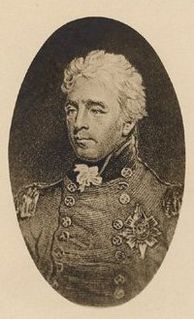
General Charles Murray Cathcart, 2nd Earl Cathcart, styled Lord Greenock between 1814 and 1843, was a British Army general who became Governor General of the Province of Canada. He was a keen amateur geologist, with enough recognition to warrant being made a Fellow of the Royal Society of Edinburgh.
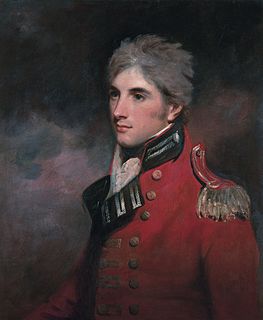
Sir George Murray was a British soldier and politician from Scotland.

Field Marshal George Hay, 8th Marquess of Tweeddale was a Scottish soldier and administrator. He served as a staff officer in the Peninsular War under Arthur Wellesley and was with Wellesley at the Second Battle of Porto when they crossed the Douro river and routed Marshal Soult's French troops in Porto. Hay also saw action at the Battle of Bussaco and at the Battle of Vitoria. He later served in the War of 1812 and commanded the 100th Regiment of Foot at the Battle of Chippawa when he was taken prisoner of war. He went on to become governor of Madras and, at the same time, Commander-in-Chief of the Madras Army, in which role he restored the discipline of the army, which had been allowed to fall into a relaxed state.
Lieutenant-General Sir Thomas Sydney Beckwith was an English officer of the British Army who served as quartermaster general of the British forces in Canada during the War of 1812, and a commander-in-chief of the Bombay Army during the British Raj. He is most notable for his distinguished service during the Peninsular War and for his contributions to the development and command of the 95th Rifles.

Lieutenant-General Sir Percy Henry Noel Lake, served as a senior commander in the British and Indian Armies, and in the Canadian Militia. He served during World War I.

General Richard Airey, 1st Baron Airey,, known as Sir Richard Airey between 1855 and 1876, was a senior British Army officer of the 19th century.
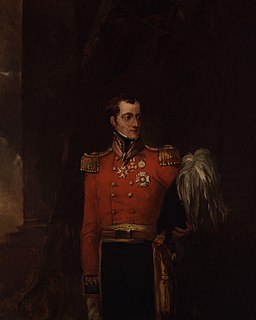
Field Marshal Sir William Maynard Gomm was a British Army officer. After taking part in the Anglo-Russian invasion of Holland, he served in most of the battles of the Napoleonic Wars. During the Hundred Days he took part in both the Battle of Quatre Bras and the Battle of Waterloo. He went on to be Commander of the troops in Jamaica and in that role established new barracks at Newcastle, Jamaica, high in the mountains. After that he became Governor of Mauritius and, finally, Commander-in-Chief, India, in which role he introduced promotion examinations for officers.

The 42nd Regiment of Foot was a Scottish infantry regiment in the British Army also known as the Black Watch. Originally titled Crawford's Highlanders or the Highland Regiment and numbered 43rd in the line, in 1748, on the disbanding of Oglethorpe's Regiment of Foot, they were renumbered 42nd and in 1751 formally titled the 42nd (Highland) Regiment of Foot. The 42nd Regiment was one of the first three Highland Regiments to fight in North America. In 1881 the regiment was named The Royal Highland Regiment , being officially redesignated The Black Watch in 1931. In 2006 the Black Watch became part of the Royal Regiment of Scotland.

Lieutenant-General Sir Colin Campbell was a British Army officer and colonial governor.
Lieutenant General Sir Thomas Arbuthnot, KCB was a British Army commander.

General Henry Edward Fox was a British Army general who served brief spells as Governor of Minorca and Governor of Gibraltar.
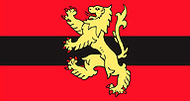
Scottish Command or Army Headquarters Scotland is a command of the British Army.
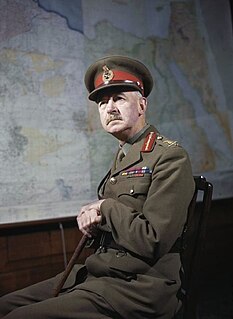
General Sir Thomas Sheridan Riddell-Webster was Quartermaster-General to the Forces during the Second World War.

Lieutenant General Sir Jasper Nicolls KCB was Commander-in-Chief, India.

General Sir James Willoughby Gordon, 1st Baronet was a general officer in the British Army. He notably served as most long-standing Quartermaster-General to the Forces, holding the position for some 40 years.
Lt.-Gen. Hay MacDowall was a Scottish officer in the British Army who was the sixth General Officer Commanding, Ceylon. He was appointed on 19 July 1799. He was succeeded by David Douglas Wemyss. Fort MacDowall in Matale was named due to his involvement during Kandyan Wars. Only the remnants of gateway and portion of the ramparts are exist today.

Lieutenant-General Sir Neil Douglas was a British Army officer who fought at the 1815 Battle of Waterloo and later became Commander-in-Chief, Scotland.
General Sir Thomas Erskine Napier was a British Army officer who became Commander-in-Chief, Scotland.
General Sir William Henry Sewell, was a senior officer in the British Army.

Lt.-General Sir William WarreKTS was an English officer of the British Army. He saw service in the Peninsular War and was colonel of the 94th Foot.















